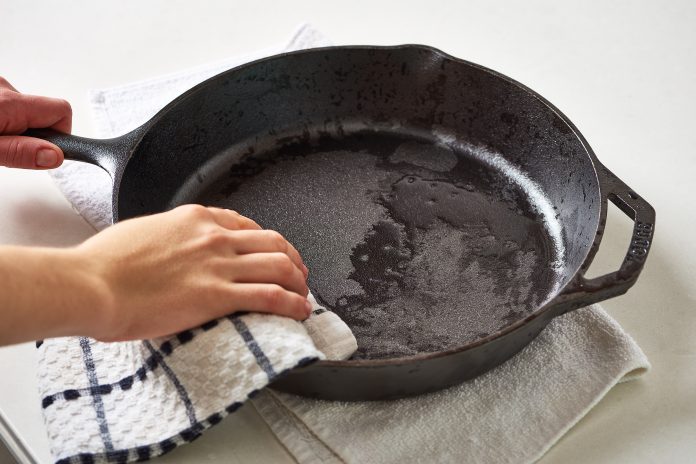Cast-iron skillets are made of iron alloyed with a small amount of carbon to harden the material. Dense and a relatively poor conductor, cast iron can hold a lot of heat for a long amount of time, making it ideal for superhot applications, such as searing a steak. Since cast-iron pans are oven-safe, you can also use them to roast vegetables or bake skillet cornbread.
The biggest challenge with cast iron pans is cleaning them properly so that they don’t lose their seasoning and develop rust. Seasoning refers to a layer of oil that has been cooked into the pores of the iron and prevents the cast iron from rusting. Seasoning also prevents food from sticking to the pan.
Here are the steps for cleaning your cast iron pan after you’ve used it:
- First, let the pan cool. Scrape out any big bits of cooked-on food. If stuff is baked on, boil some water in the pan to loosen it.
- Now, using a stiff-bristled brush or scrubber, scrub out the pan with mild soap and hot water. A lot of people will tell you not to use soap because they’re afraid the soap will dissolve your seasoning. The trouble is, there’s a difference between seasoning and grease. You don’t want to leave a layer of grease on the pan, as it will eventually turn rancid and make your food taste bad. So do use a mild soap; you’ll be glad you did.
- Rinse the pan thoroughly, dry it with a clean kitchen cloth (the cooking surface and the underside) and set it on the stovetop. Heat it for just a minute and pour a small amount of cooking oil onto the pan. A drop the size of a quarter is plenty. Now use a kitchen cloth to rub that oil all over the surface of the pan. Get it into the corners and up the sides, too. Don’t use a paper towel for this because you may leave a lot of tiny paper fibers all over the skillet.
So that’s it. Wash, dry, and oil. Follow these simple steps, and your cast iron cookware will give you years of use.
Do’s:
A)Clean Immediately After Use
Try to rinse your cast-iron pan right after cooking. This’ll prevent clingy food scraps like eggs or sauces from hardening and sticking to the pan. (You can also pour a glass of hot water into the pan while it sits on the stove.) Wait until the cast-iron has cooled enough to handle, then hand wash in the sink. And, yes it is OK to get your pan wet.
B)Use Hot Water and Soap
It’s a common misconception that soap will strip the seasoning from your pan. A little soapy water now and then will help banish stuck-on food and reduce the elbow grease. Hot water helps dissolve the bits better.
C)Dry Well and Oil
Instead of leaving your pan in the rack to dry, wipe it down with a clean rag (don’t use a light towel-the cast iron can stain it) or paper towel right away. This will prevent rusting. Let your pan dry right on your stovetop or even in the oven.
Extra credit: Reinforce your seasoning after a wash. While the pan is warm, apply a light coat of vegetable oil with a paper towel.
Don’ts:
A)Let the Pan Soak Too Long
Although you might be tempted to toss your skillet in a sudsy sink while you eat, avoid letting it soak. Cast-iron is not rust-proof! Make sure to minimize the amount of time it comes into contact with water. (This means no dishwasher, either!)
Just a quick heads up: Submerging an extremely hot pan in cold water can cause it to crack. So don’t do it.
B)Use an Abrasive Scrubber
Abrasive scrubbers like scouring pads or steel wool will take off your hard-earned seasoning.
C)Stress
A little rust or scrubbed-off seasoning isn’t the end of the world. You can always scour off rust and re-season the pan. Remember, these pans are extremely durable. With a little care, they’ll last you a lifetime.
































